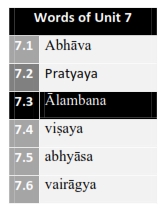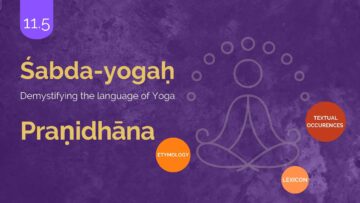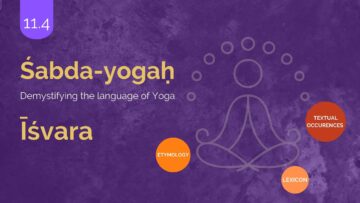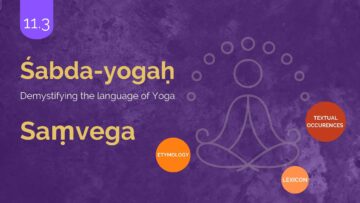Introduction
In this series, Yogic terminologies will be taken up and their –
- Etymological analysis,
- Lexical descriptions and
- Textual occurrences in Yogic literature and their commentaries, as available, will be presented. And finally observations will be made on the references.
Three texts – Yogasūtra, Haṭha-yoga-pradīpikā and Bhagavad-gītā are consulted for textual occurrences portion.
Śabda-yoga is intended to help students, teachers, and professionals of Yoga to develop a sound grammatical, contextual, and thereby an authentic and immersive understanding of Yoga terminologies.
7.3 Ālambana
आङ् + लम्ब + ल्युट् = आलम्बनम्
āṅ + lamba + lyuṭ = ālambanam
The prefix is āṅ
The root is lamba – लम्ब्अवस्रंसने – lamb avasraṃsane. The meaning of the root is to hang down.
The suffix is lyut. It indicates the object of actions (karma). This suffix is added to the root based on the grammatical rule कृत्यल्ल्युटोबहुलम्kṛtyallyuṭo bahulam (aṣṭādhyāyī3.3.113)
Based on the grammatical derivation the derivation statement of the word can be as follows – आलम्ब्यतेयत्तत्आलम्बनम् – ālambyate yat tat ālambanam – the support of that which is taken to hang on.
Lexicon – There are no entries of this term in Amarakośa
Textual Occurrences
Yogasūtra
There are four occurrences to the term in this text. They are as follows –
अभावप्रययालम्बनावृत्तिर्निद्रा॥१.१०॥
स्वप्ननिद्राज्ञानालम्बनंवा॥१.३८॥
नचतत्सालम्बनंतस्याविषयीभूतत्वात्॥३.२०॥
हेतुफलाश्रयालम्बनैःसंगृहीतत्वादेषामभावेतदभावः॥४.११॥
abhāvaprayayālambanā vṛttirnidrā .. 1.10 ..
svapnanidrājñānālambanaṃ vā .. 1.38 ..
na ca tatsālambanaṃ tasyāviṣayībhūtatvāt .. 3.20 ..
hetuphalāśrayālambanaiḥ saṃgṛhītatvādeṣāmabhāve tadabhāvaḥ .. 4.11 ..
Summary: The word Ālambana, in the context of Yogasūtra, in all these four references, has been used in the sense of that support/object based on which vṛtti/knowledge arises. In sūtra 1.10 the Virtti Nidrā arises by taking the cause of absence of waking and dream states (Tamas) as ālambana (support). In sūtra 1.38 Sage Patañjali prescribes experiences in the state of dream and deep sleep as an ālambana for the citta to attain calm and pleasant state (citta-prasādana). Sūtra 3.20 is a clarification about the Siddhi mentioned in the previous Sūtra. The previous Sūtra mentions about the power of knowing the other persons mind. It is clarified in this Sūtra (3.20) that the Siddhi mentioned in the previous Sūtra is limited only to knowing the state of the mind of others and the ālambana/the object that led such a state of mind of the person shall not be known by the Yogin. 4.11 discusses methods to overcome the Vāsanas. According to the commentary of Sadāśiva Brahmendra on this Sūtra, Vāsanas manifest when the cause (hetu – kleśas and actions), phala (karmaphala – such as jāti/āyus/bhoga), substratum (citta) and Ālambana (the support/objects of the senses) exist. If these are removed vāsanas can also be overcome.
Bhagavadgita & Hathayogapradeepika –References to the term Ālambana is not found in these two texts.
Tabulation of Textual References
It could be noted that –
1)Such an important term Ālambana is found only to be used Yogasūtras.
2)The meaning of the term is consistently maintained across the usages in various parts of Yogasūtras – as the support for Vṛttis to arise.
3)It is interesting to noted that while certain ālambanas are prescribed (1.38) to attain peaceful state of mind, complete removal of ālambanas (4.11) is also advised later in the text to overcome Vāsanas, the root cause of all sufferings.
Hence it is essential to note these aspects of Ālambana in Yogasūtras to understand the term better.
References
- Advaitaśāradā – https://advaitasharada.sringeri.net/
- Amarakoṣasampat – http://amara.aupasana.com/
- Aṣṭādhyāyī – https://ashtadhyayi.com/
- Aksharamukha – https://aksharamukha.appspot.com/
- Avyayakośaḥ, śrīśrīvatsāṅkācāryaḥ, saṃskṛtavidyāsamitiḥ, chennai, 2004
- Gītā Supersite – https://www.Gītāsupersite.iitk.ac.in/
- Nāmaliṅgānuśāsana alias amarakoṣa of amarasiṃha with the commentary vyākhyāsudhā or rāmāśramī by bhānuji dīkṣita, Edited with notes by M.M.Pandit Shivadatta Dadimatha, Chaukhamba Saṃskṛta Prathisthan, Delhi, Reprint 2002
- śabdārthakaustubha, cakravartī śrīnivāsagopālācārya, Vol 4, Bappco Publication, Bengaluru, Reprint 2009
- Yoga-vaiśāradī – https://kymyogavaisharadi.org/
Unit 7 To be Continued…
Links for previous posts in this unit
Disclaimer: The opinions expressed in this article belong to the author. Indic Today is neither responsible nor liable for the accuracy, completeness, suitability, or validity of any information in the article.













